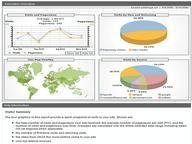Quiz Answer Key and Fun Facts
1. You have 4 coins. Three of the coins are normal, but one of them is heads on both sides. You pick a coin at random without looking. The coin you pick has heads on one side. What are the odds that if you flip the coin over, the other side will be tails?
2. If you roll three normal 6-sided dice, what are the odds that the dice rolls add up to 16?
3. If you randomly flip 5 normal coins, then what is the probability that you roll 3 tails and 2 heads?
4. If you randomly guessed on the last three multiple choice problems, then what is the probability you got at least one of them correct?
5. The answer to a fill-in-the-blank question is a five-digit number that is a palindrome (a number that reads the same backwards and forwards). If you make an educated guess based on the fact the 5-digit number is a palindrome, then the odds of getting the question right are 1 out of what number?
The answer is just a numeral like 52 or 420 or 62848112.
6. If you randomly guessed on 5 questions with 4 answer choices each, then what is the probability you got exactly two correct?
7. A game show requires you to randomly pick 1 of 6 envelopes. The host has hidden a $100 bill in one envelope, and a $1 bill in each of the other 5. Once you've picked, the host is required to remove 2 $1 envelopes you didn't pick. You now have a choice of keeping your original envelope, or paying $2 to switch your choice to one of the 3 you didn't pick.
If you choose to pay $2 and switch your choice, then what are your odds of losing money?
8. Let's say conceiving a girl is twice as likely to happen as conceiving a boy. If you have 3 children based on those odds, what would be the probability that you have two boys and a girl?
9. A toy factory generates cubes with a random color (red or blue) on each side. You buy 7 of the cubes and all your cubes have a different number of blue squares. You select one of your cubes at random and happen to pull up a cube showing only one side, which is red. What is the probability that at least two other squares are also red?
10. You randomly answer 4 multiple choice problems with 4 choices each. What is the probability that you get at least two correct?
Source: Author
iggy4
This quiz was reviewed by FunTrivia editor
crisw before going online.
Any errors found in FunTrivia content are routinely corrected through our feedback system.


